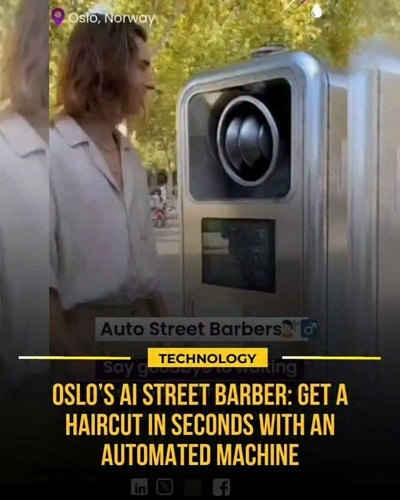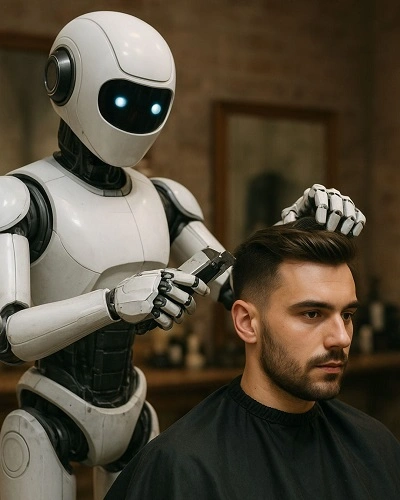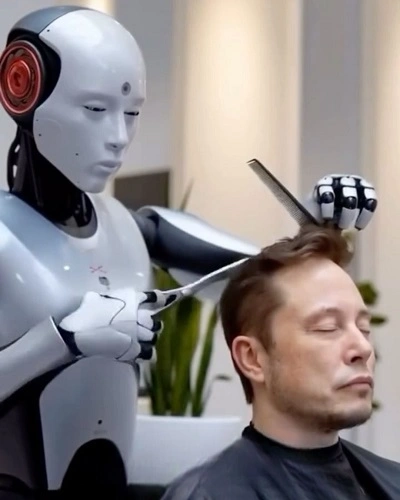Viral Scene: Street AI Barbers?
Imagine strolling down a crisp autumn afternoon in Oslo’s lively streets and seeing a sleek kiosk machine quietly nestled on the pavement. A person steps up, taps a screen, receives a helmet like collar, leans forward and within seconds emerges with a fresh taper fade haircut. That’s the scenario depicted in a video circulating widely online, purporting to show a fully automated street AI Barber in Norway’s capital.
The clip claims to be filmed in Oslo: an outdoor, unattended AI Barber handles cuts on demand, offering an experience of “instant grooming” without waiting for a human barber. It’s garnered tens of thousands of likes and shares; capturing imaginations around the fusion of AI, automation, grooming and public convenience.
Reality Check: Fact vs. Fanciful Future

Here’s the catch: despite its seamless presentation, the “Oslo automated AI Barber kiosk” video is not real. Investigations reveal it is AI generated / digitally manipulated content from an Instagram account known for speculative futuristic visuals. Let’s break down what’s actually true and what’s still science fiction:
What is real:
- The concept of AI Barber or automated haircut machines is under academic and industry exploration. For example, research examines technical foundations; including hair modelling, motion planning and safety certification.
- The grooming industry is seeing AI assistive tools: e.g., professional AI powered hair clippers that adapt in real time to hair type and texture, supporting barbers and AI Barbers alike.
What is not real (yet):
- A fully automated AI Barber sidewalk machine giving real haircuts in seconds, unsupervised, at scale. The viral “Oslo AI Barber” is staged/AI generated.
- Robust public infrastructure and regulatory approval for AI Barber machines in outdoor urban settings.
So: the dream is here, but the execution remains aspirational.
Why this Concept Resonates Right Now?

The viral AI Barber idea taps into several converging trends:
1. Urban convenience culture
Fast moving city dwellers increasingly favour “on the go” services: coffee, laundry, groceries; and maybe soon an AI Barber without booking an appointment. The notion of a sidewalk AI Barber kiosk for grooming matches this “instant” mindset.
2. Automation + AI in everyday services
From cashier free stores to robot baristas, automation is creeping into daily life. An AI Barber is a natural extension of that trajectory. Haircutting AI Barbers are being developed as hardware costs fall and demand rises.
3. Social media and spectacle
The AI Barber idea is inherently share worthy: “I got my hair cut by an AI Barber on the street” is weird, futuristic and photo worthy. The video taps into that shareability with ease.
4. Friction in traditional services
Waiting, booking, price variances, stylist mismatch; there are genuine pain points in the classic barber experience. An AI Barber kiosk promises uniformity, availability and potentially lower cost.
Possible Upsides: What If AI Barbers Worked?

Here are what potential benefits of a true AI Barber could look like:
- Ultra fast turnarounds: No appointment, walk in any time, rapid stylings.
- 24/7 availability: AI Barbers don’t need to clock out; could serve late night crowds or early risers.
- Cost efficiency & scaling: Fewer skilled human barbers needed, potentially lower cost per haircut (though hardware amortisation matters).
- Precision and consistency: With advanced sensors, an AI Barber could replicate the same cut style each time; less variability than human barbers.
- Hygiene and isolation appeal: For people uneasy about close human contact, an AI Barber might feel safer or simply novel.
Big Questions & Concerns

Many challenges loom for AI Barbers. Here are key concerns:
1. Safety & liability
Cutting hair involves sharp blades, skin near the scalp, ears, neck. What happens if the AI Barber mechanism stalls, mis aligns or the user moves unexpectedly?
2. Experience & human touch
Barbering isn’t just technical: conversation, personal rapport, subtle judgement of hair texture, face shape, styling suggestions; these human elements are hard to encode. Will AI Barbers ever replicate that charm?
3. Customization & complexity
Hair types vary widely; straight, curly, coarse, fine, long, short, layered, coloured. Can an AI Barber adapt dynamically or will many users be stuck with generic cuts?
4. Cost and maintenance
Hardware, sensors, moving parts, cleaning, vandalism risk; all add costs. AI Barbers might need frequent calibration, maintenance downtime and still need someone on call.
5. Acceptance & aesthetics
Will people trust an AI Barber with their head? Will people feel comfortable surrendering to robot instrumentation in public?
6. Impact on jobs
What happens to barbers? AI Barbers might displace some roles or shift the skill set required (maintenance, monitoring, customer service).
Why Oslo? And Why It Matters?
Choosing Oslo as the setting for the viral AI Barber concept is curious; but meaningful.
- Norway is forward looking in terms of digital infrastructure, automation research and public services.
- The viral AI Barber post capitalises on the Scandinavia futurism trope: clean infrastructure, design centric cities, tech friendly citizens.
- Locally, Oslo has high density of barbershops. The idea of augmenting or automating that high volume service with AI Barbers has cultural plausibility.
What’s Next: From Idea to Reality?

Where might AI Barbers head from here?
1. Short term (1 to 3 years)
- Pilot indoor AI Barber machines in controlled environments.
- Augmented tools for human barbers: AI Barber clipper devices that assist rather than replace humans.
2. Mid term (3 to 5 years)
- Outdoor AI Barber kiosks in guarded environments with human oversight remotely or on site.
- Data collection, user style library development, personalization via user profiles and face/head scans.
3. Long term (5 to 10 years)
- Fully autonomous street side AI Barbers integrated into urban infrastructure.
- Possibly augmented reality (AR) previews, style selection via app, integration with hair care product dispensers.
What This Means Globally?
Though the viral AI Barber is “in Oslo”, the implications resonate worldwide:
- High density urban areas could benefit from drop in AI Barber services where human barbers are scarce or charge premium rates.
- Hybrid models could bring down cost of haircuts or enable new business models (pay per cut AI Barbers in malls, stations).
- Barbers might need to upskill; offering premium human touch services alongside AI Barbers.
- Regulatory and hygiene issues vary; adoption pace depends on local trust and infrastructure.
- Cultural preferences matter: the interaction with a barber is embedded in the haircut experience; AI Barbers may face resistance.
Final Thoughts
The “AI street barber” kiosk in Oslo is not yet reality but it’s a powerful indicator of what is coming. It illustrates how grooming; traditionally a purely human skill service; could be disrupted by AI Barbers. The idea rouses fascination because it combines: human need, convenience, novelty and social spectacle.
For now, if you’re in Oslo or anywhere else, your haircut will likely still involve a barber chair, snip of scissors, conversation and maybe a magazine. But keep an eye out: the next time you step up for a trim, the person or the AI Barber; doing it might well be a machine.



